Strindberg August

Johan August Strindberg ( pronounced (help·info) (22 January 1849 – 14 May 1912) was a Swedish playwright and writer. He is arguably the most influential of all Swedish authors, and one of the most influential Scandinavian authors, along with Knut Hamsun, with whom he fraternized while in Paris during the mid 1890s, Henrik Ibsen, Søren Kierkegaard and Hans Christian Andersen. Strindberg is known as one of the developers of modern theatre. His work is of two major literary styles, Naturalism and Expressionism.[1] Strindberg was the third son of Carl Oscar Strindberg, a shipping agent, and Ulrika Eleonora (Nora) Norling. Ulrika was twelve years Carl's junior and of humble origin, called a "domestic servant woman" by Strindberg. He used this expression in the title of his autobiographical novel, Tjänstekvinnans son (The Son of a Servant). Strindberg's paternal grandfather Zacharias was born during 1758 to a clergyman in Jämtland and settled in Stockholm, where he became a successful spice tradesman and a major of the Burghers' Military Corps. Strindberg's aunt Johanna Magdalena Elisabeth Strindberg (1797-1880), also called "Lisette", was married to the inventor and industrialist Samuel Owen (born 1774 in Norton-in-Hales, Shropshire, England, died February 15, 1854 in Stockholm) who went to Sweden during 1804 to help with the installation of the first steam engines for industrial use in Sweden and later during 1806 set up his own workshop 'Kungsholms Mekaniska Verkstad' in Stockholm. Carl Oscar Strindberg's older brother Johan Ludvig Strindberg was a successful businessman, the model for the protagonist Arvid Falk's wealthy and socially ambitious uncle in Strindberg's novel Röda rummet (The Red Room)Strindberg's own version of his childhood is available in his novel The Son of a Servant, but at least one of his biographers, Olof Lagercrantz, warns against its use as a biographical source. Much of what Strindberg wrote has an autobiographical character, but Lagercrantz notes Strindberg's "talent to make us believe what he wants us to believe," and his unwillingness to accept any characterization of his person other than his own. From the age of seven, Strindberg matured in the Norrtull area on the northern, almost-rural periphery of Stockholm, not far from Tegnérlunden, the park where Carl Eldh's grand statue of Strindberg was later placed. He went to the elementary schools of Klara and Jakob parishes, continuing to the Stockholms Lyceum, a progressive private school for middle-class boys. He completed his graduation exam studentexamen on May 25, 1867, and matriculated at the University of Uppsala in the autumn. Strindberg would spend the next years in Uppsala and Stockholm, alternately studying for exams and trying his hand at non-academic pursuits. As a young student, Strindberg also worked as an assistant in a chemist's shop in the university town of Lund in southern Sweden. He first left Uppsala during 1868 to work as a schoolteacher, but then studied chemistry for some time at the Institute of Technology in Stockholm in preparation for medical studies, later working as a private tutor before becoming an extra at the Royal Theatre in Stockholm. He returned to Uppsala during January 1870 to study and work on a set of plays, the first of which began at the Royal Theatre during September 1870, a biography of the Danish sculptor Bertel Thorvaldsen. In Uppsala, he started Runa, a small literary club with friends who all took pseudonyms from Nordic mythology; Strindberg called himself Frö after the god of fertility. He spent a few more semesters in Uppsala, finally leaving during March 1872 without graduating. He would often ridicule Uppsala and its professors, as when he published Från Fjerdingen och Svartbäcken ("From Fjerdingen and Svartbäcken", 1877), short stories describing Uppsala student life. After leaving university for the last time, he embarked on his career as a journalist and critic for newspapers in Stockholm. The history of the Paris Commune during 1871 caused young Strindberg to develop the opinion that politics is a conflict between the upper- and lower classes. He was admired by many as a radical writer. He was a socialist (or perhaps more of an anarchist, which he himself claimed on at least one occasion ). Strindberg's political opinions nevertheless changed considerably within this category over the years, and he was never primarily a political writer. Nor did he often campaign for any one issue, preferring instead to scorn his enemies manifesto-style— the military, the church, the monarchy, the politicians, the stingy publishers, the incompetent reviewers, the narrow-minded, the idiots —and he was not loyal to any party or ideology. Many of his works however had at least some politics and sometimes an abundance of it. They often displayed the conviction that life and the prevailing system was profoundly unjust and injurious to ordinary citizens. The changing nature of his political positions is perhaps illustrable by the women's rights issue. Early on, Strindberg was sympathetic to women of 19th-century Sweden, calling for women's suffrage as early as 1884. However, during other periods he had wildly misogynistic opinions, calling for lawmakers to reconsider the emancipation of these "half-apes ... mad ... criminal, instinctively evil animals". This has become controversial in contemporary assessments of Strindberg, as have his antisemitic descriptions of Jews (and, in particular, Jewish enemies of his in Swedish cultural life) in some works (eg. Det nya riket), particularly during the early 1880s. Strindberg's antisemitic pronouncements, just like his opinions of women, have been debated, and also seem to have varied considerably. Many of these attitudes, passions and behaviours may have been developed for literary reasons and ended as soon as he had exploited them in books.[2] In satirizing Swedish society—in particular the upper classes, the cultural and political establishment, and his many personal and professional foes—he could be very confrontational, with scarcely-concealed caricatures of political opponents. This could take the form of brutal character disparagement or mockery, and while the presentation was generally skilful, it was not necessarily subtle. His daughter Karin Strindberg married a Russian Bolshevik of partially Swedish ancestry Vladimir Martynovich Smirnov ("Paulsson").[3] Because of his political views, Strindberg was promoted strongly in socialist countries in Central and Eastern Europe, as well as in the Soviet Union and Cuba. A multi-faceted author, Strindberg was often extreme. His novel The Red Room (Röda rummet) (1879) made him famous. His early plays were written in the Naturalistic style. His works from this time are often compared with the Norwegian playwright Henrik Ibsen. Strindberg's best-known play from this period is Miss Julie (Fröken Julie). His most popular and maybe his best novel is Natives of Hemsö (Hemsöborna). Strindberg wanted to attain what he called "Greater Naturalism." He did not prefer expository character backgrounds seen in the work of Ibsen, or write plays that gave his audiences a "slice of life" because he felt that these plays were mundane and uninteresting. Strindberg felt that true naturalism was a psychological battle of brains (hjärnornas kamp). Two people who hate each other in the immediate moment and strive to drive the other to doom is the type of mental hostility that Strindberg strove to describe. Furthermore, he intended his plays to be impartial and objective, citing a desire to make literature somewhat of a science. Later, he had a time of inner turmoil known as the "Inferno Period", which culminated in the production of a book written in French, Inferno. He also exchanged a few cryptic letters with Nietzsche. Strindberg subsequently ended his association with Naturalism and began to produce works informed by Symbolism. He is considered one of the pioneers of the Modern European stage and Expressionism. The Dance of Death (Dödsdansen), A Dream Play (Ett drömspel) and The Ghost Sonata (Spöksonaten) are well-known plays from this period. One year before his death, his main book publisher Albert Bonniers förlag bought the rights to all his writings for 200,000 Swedish crowns, a fortune at that time, which Strindberg shared with his children. Strindberg, something of a polymath, was also a telegrapher, painter, photographer and alchemist. Painting and photography offered venues for his belief that chance played a crucial part in the creative process.[4] Strindberg's paintings were unique for their time, and went beyond those of his contemporaries for their radical lack of adherence to visual reality. The 117 paintings that are acknowledged as his, were mostly painted within the span of a few years, and are now seen by some as among the most original works of nineteenth century art.[5] Today, his best-known pieces are stormy, expressionist seascapes, selling at high prices in auction houses. Though Strindberg was friends with Edvard Munch and Paul Gauguin, and was thus familiar with modern trends, the spontaneous and subjective expressiveness of his landscapes and seascapes can be ascribed also to the fact that he painted only in periods of personal crisis.[6] The Town, 1903 A Coast, 1903 The White Mare II, 1892 Seascape, 1894 His interest in photography resulted, among other things, in a large number of arranged self-portraits in various environments, which now number among the best-known pictures of Strindberg. Alchemy, occultism, Swedenborgianism, and various other eccentric interests were pursued by Strindberg with some intensity for periods of his life. In the curious autobiographical work Inferno—a paranoid and confusing tale of his years in Paris, written in French—he claims to have successfully performed alchemical experiments and cast black magic spells on his daughter. Strindberg was married three times, to Siri von Essen (1850–1912), Frida Uhl (1872–1943), and Harriet Bosse (1878–1961). He had children with all his wives. Late during his life he met the young actress and painter Fanny Falkner (1890–1963), whose book illuminates his last years, but the exact nature of their relationship is debated. He had a brief affair in Berlin with Dagny Juel before his marriage to Frida; it has been suggested that the news of her murder was the reason he cancelled his honeymoon with his third wife, Harriet.
do you like this author?
What readers are saying
What do you think? Write your own comment on this book!
write a commentWhat readers are saying
What do you think? Write your own comment on this author!
write a commentBook list

Tjensteqvinnans sonEn själs utvecklingshistoria
Series:
Unknown
Year:
Unknown
Raiting:
3.5/5
Show more
add to favoritesadd In favorites

Det Nya Riket
Skildringar från attentatens och jubelfesternas tidevarv
Series:
Unknown
Year:
Unknown
Raiting:
5/5
Show more
add to favoritesadd In favorites

Samlade Skrifter #28Hemsöborna och Skärkarlsliv
Series:
Unknown
Year:
Unknown
Raiting:
4/5
Show more
add to favoritesadd In favorites
Book list

Tjensteqvinnans sonEn själs utvecklingshistoria
Series:
Unknown
Year:
Unknown
Raiting:
3.5/5
Show more
add to favoritesadd In favorites

Det Nya Riket
Skildringar från attentatens och jubelfesternas tidevarv
Series:
Unknown
Year:
Unknown
Raiting:
5/5
Show more
add to favoritesadd In favorites

Samlade Skrifter #28Hemsöborna och Skärkarlsliv
Series:
Unknown
Year:
Unknown
Raiting:
4/5
Show more
add to favoritesadd In favorites
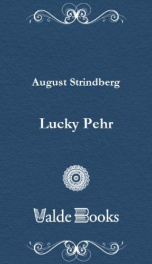
Lucky Pehr
Series:
Unknown
Year:
Unknown
Raiting:
4/5
Lucky Pehr. please visit www.valdebooks.com for a full list of titles
Show more
add to favoritesadd In favorites
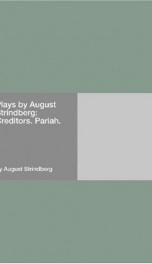
Plays by August Strindberg: Creditors. Pariah.
Series:
Unknown
Year:
Unknown
Raiting:
5/5
This book was converted from its physical edition to the digital format by a community of volunteers. You may find it for free on the web. Purchase of the Kindle edition includes wireless delivery. --This text refers to the Kindle Edition edition.
Show more
add to favoritesadd In favorites
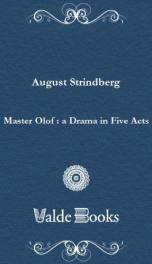
Master Olof : a Drama in Five Acts
Series:
Unknown
Year:
Unknown
Raiting:
4/5
Master Olof : a Drama in Five Acts. please visit www.valdebooks.com for a full list of titles
Show more
add to favoritesadd In favorites

Plays: the Father; Countess Julie; the Outlaw; the Stronger
Series:
Unknown
Year:
Unknown
Raiting:
3.5/5
August Strindberg was a 19th century Swedish playwright and painter. He was one of the father's of the modern theater. His work falls into the Naturalism and Expressionism literary movements. The introduction states. "Of the plays included in the present volume, "The Father" and "Countess Julie" are representative of Strindberg's high water mark in dramatic technique and have successfully maintained their claim to a permanent place, not only in dramatic literature, but, as acting plays. "The Stronger," than which no better example of Strindberg's uncanny power for analysis of the female mind exists, while essentially a chamber play, is from time to time presented at the theatre, and affords a splendid test of the dramatic ability of the actors, only one of whom speaks. The author has boldly thrown on the other the burden of maintaining her share in the development of the action by pantomime, facial expression, and an occasional laugh. "The Outlaw," although inferior in construction to the others, is still played with success and is full of dignity and atmosphere. The important part it played in promoting the fortunes of the author lends to it an added interest which fully justifies its inclusion in this volume." --This text refers to an alternate Paperback edition.
Show more
add to favoritesadd In favorites
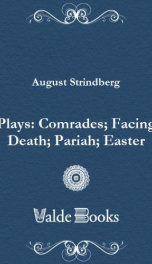
Plays: Comrades; Facing Death; Pariah; Easter
Series:
Unknown
Year:
Unknown
Raiting:
2.5/5
Plays: Comrades; Facing Death; Pariah; Easter. please visit www.valdebooks.com for a full list of titles
Show more
add to favoritesadd In favorites

There Are Crimes and Crimes
Series:
Unknown
Year:
Unknown
Raiting:
5/5
Purchase of this book includes free trial access to www.million-books.com where you can read more than a million books for free. This is an OCR edition with typos. Excerpt from book: 0- Henbiette. I don't believe it. She is simply stupider and stingier. One who weeps because you order champagne Maurice. When the child was without stockings. Yes, she is a good woman. Henriette. Philistine! You'll never be an artist. But I am an artist, and I'll make a bust of you with a shopkeeper's cap instead of the laurel wreathHer name is Jeanne? Maurice. How do you know? Henriette. Why, that's the name of all housekeepers. Maurice. Henriette! Henriette takes the tie and the gloves and throws them into the fireplace. Maurice. [Weakly] Astarte, now you demand the sacrifice of women. You shall have them, but if you ask for innocent children, too, then I'll send you packing. Henhiette. Can you tell me what it is that binds you to me? Maurice. If I only knew, I should be able to tear myself away. But I believe it must be those qualities which you have and I lack. I believe that the evil within you draws me with the irresistible lure of novelty. Henriette. Have you ever committed a crime? Maurice. No real one. Have you? Henriette. Yea Maurice. Well, how did you find it? Henriette. It was greater than to perform a good deed, for by that we are placed on equality with others; it was greater than to perform some act of heroism, for by that we are raised above others and rewarded. That crime placed me outside and beyond life, society, and my fellow-beings. Since then I am living only a partial life, a sort of dream life, and that's why reality never gets a hold on me. Maurice. What was it you did? Henriette. I won't tell, for then you would get scared again. Maurice. Can you never be found out? Henhiette. Never. But that does not prevent me from seeing, frequently, the five stones at the Place de Roquette, where the scaffol...
Show more
add to favoritesadd In favorites
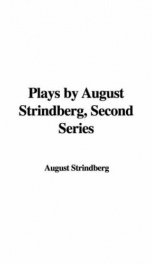
Plays by August Strindberg, Second series
Series:
Unknown
Year:
Unknown
Raiting:
4.5/5
TRANSLATED WITH INTRODUCTIONS BY EDWIN BJ¿RKMAN. --This text refers to an alternate Paperback edition.
Show more
add to favoritesadd In favorites
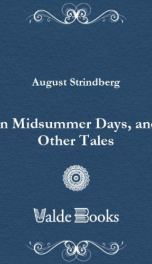
In Midsummer Days, and Other Tales
Series:
Unknown
Year:
Unknown
Raiting:
5/5
In Midsummer Days, and Other Tales. please visit www.valdebooks.com for a full list of titles
Show more
add to favoritesadd In favorites
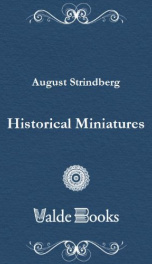
Historical Miniatures
Series:
Unknown
Year:
Unknown
Raiting:
3.5/5
Historical Miniatures. please visit www.valdebooks.com for a full list of titles
Show more
add to favoritesadd In favorites
What readers are saying
What do you think? Write your own comment on this author!
write a commentif you like Strindberg August try:
readers also enjoyed
What readers are saying
What do you think? Write your own comment on this author!
write a commentGenre
if you like Strindberg August try:
readers also enjoyed
Do you want to read a book that interests you? It’s EASY!
Create an account and send a request for reading to other users on the Webpage of the book!

